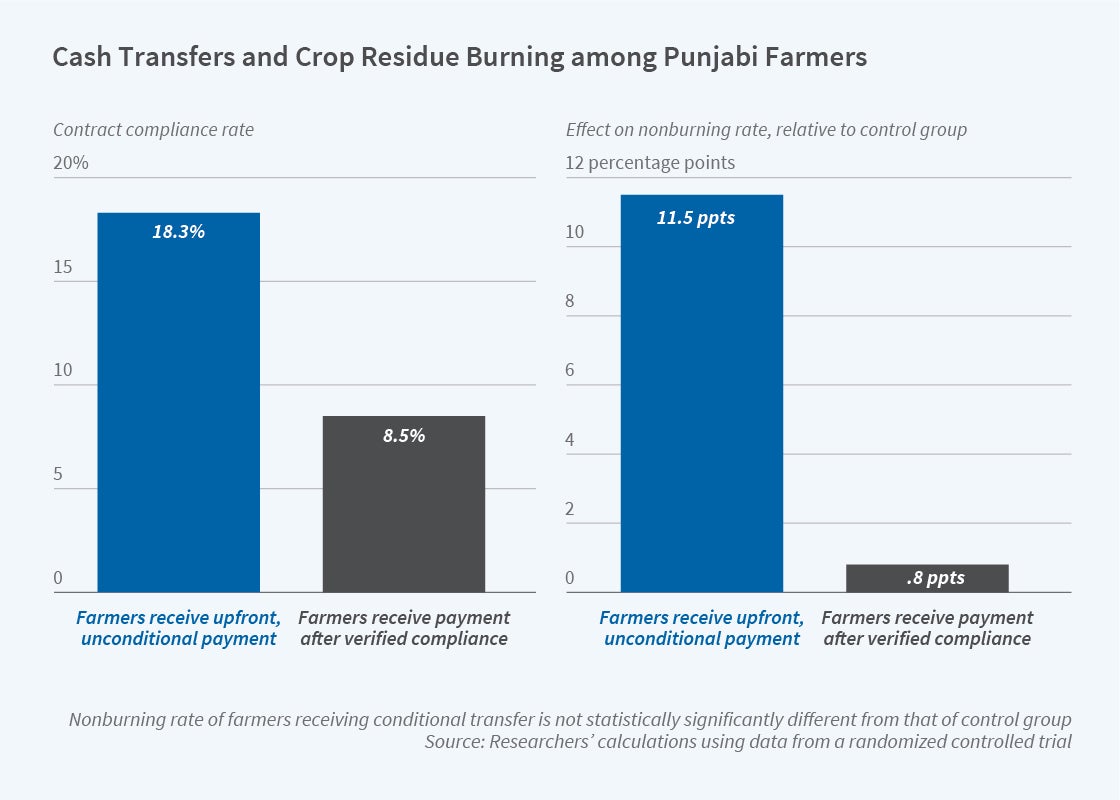Paying Indian Farmers Not to Burn Agricultural Residue

In 2015, in an attempt to combat its poor air quality, India banned the burning of agricultural residues. But bans have not worked, and pollution from fires used to clear fields after harvest has continued making the air quality worse.
In Money (Not) to Burn: Payments for Ecosystem Services to Reduce Crop Residue Burning (NBER Working Paper 30690), B. Kelsey Jack, Seema Jayachandran, Namrata Kala, and Rohini Pande test an alternative: paying farmers who forgo burning and use alternatives instead. They find that such payments can work, but only if farmers are given some of the payment before they take action to dispose of crop residues.
Every winter, farmers in North India set fire to some 8.7 million acres of farm land to clear rice stalks from their fields and prepare for wheat planting. The practice is cheap, but has proved to be a major contributor to the nation’s high levels of air pollution and to associated adverse health effects. Using estimates of the impact of high levels of airborne particulates on mortality, and assuming that a human life is valued at $1 million, the researchers calculate that the mortality cost of burning one acre of rice stalks is about $7,600. An acre of rice creates some $500 in annual revenue. Net of farm production costs, profit per acre is far lower.
The researchers find that incentives are misaligned: costs of burning are spread over millions of people while benefits accrue to a relative few. Enforcement of the burning ban is patchy, and government subsidies aimed at bringing down the price to rent equipment that handles the residue without burning have been unsuccessful.
In 2019, they tested another solution — Payments for Ecosystem Services (PES) contracts, which pay farmers directly if they stop burning. They set up a PES program in 171 Punjabi villages and divided farmers into three groups: those without a contract (the control group), those with a standard contract, and those with a contract and partial payment in advance. Farmers in the third group were told explicitly that these upfront payments were unconditional, so even if they reneged on their commitment not to burn, they would only lose the final payment of the contract, not the upfront money.
This last group was the only one that reduced burning. The group with the standard contract, which received a payment if they refrained from burning, but after the fact, showed no significant difference with the control group, which had no contract. Some of the standard-contract recipients qualified for payment, but they were only the farmers who would not have burned their crop residues anyway. The likelihood that a farmer who received partial payment in advance complied with the contract was 10 percentage points above the compliance rate of those with the standard contract.
Why did farmers who had already received money upfront follow through with alternative measures, even though their final payment was smaller than payments to those with standard contracts, whose payments all came at the end? One factor appears to be trust. Those who got advance payments expressed more trust in the receipt of a future payment than those with the standard contract. Also, the upfront cash may have helped them pay for alternatives to burning. Some 70 percent of farmers said their cash on hand affected their crop residue management decisions.
Even though a substantial number of farmers took the upfront money and continued to burn their fields, the program still cost only $34 to $50 per acre not burned — a small price compared with the avoided mortality costs or the costs of other pollution abatement programs, such as installing scrubbers on India’s coal-fired power plants. Other research has estimated that it costs $400,000 in scrubber upgrades to save a life, while this study found that upfront PES costs between $4,800 and $7,200 per life saved.
— Laurent Belsie


